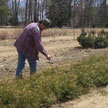

Seed to Seedling
From Seed to Seedlings
Collection
Late summer and fall are optimum for collecting fruits and seeds of many species. Collection or harvesting begins as soon as fruits, cones or seeds are mature. Sometimes proper timing can be a chore particularly with species whose seed ripen and disperse quickly or are highly attractive to birds and mammals.
Picking or stripping fruit or seeds by hand from the plant or the ground is the most common collection method. Mature trees usually require climbing or branch clipping. Prompt collection of fallen fruit is necessary to reduce losses to fungi, insects, animals and birds.
Keeping track of seed sources, or seed lot identity, is very important so each container of collected fruit or seed must be labeled properly. Care in handling and storage of collected fruit and seed is critical to prevent damage or disease.
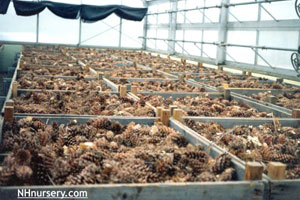
Cone Drying
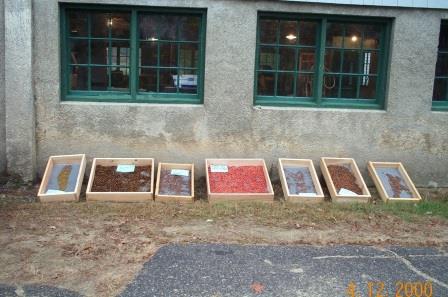
Hardwood Seed Drying
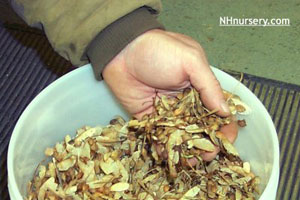
Sugar Maple Seed before cleaning
Processing
Processing methods are designed for three general types of fruits*– for cones, for fleshy fruit, and for dry fruits. Seed of most cones are obtained by drying cones to open them, shaking seeds out, separating seeds from cone scales and debris, loosening seed wings, and finally separating clean full seeds from wings, dust, empty seeds, and other small particles.
Fleshy fruits include the berries, drupes, pomes, and those with seeds enclosed in a fleshy aril. Processing involves macerating the flesh, separating the seeds with copious use of water, drying, and cleaning. After separation, wet seed must by dried in trays in the sun or indoors. Final cleaning is desirable before storage.
Air-drying is generally adequate for seeds of dry fruits. Some fruits of this group are collected when fully dry, e.g. maples, oaks, and ashes. They may require cleaning but little else prior to storage.
Storage
The key purpose for storing tree and shrub seed is to have a viable supply whenever it may be needed. Seeds of most species must be stored for weeks or months between time of collection and next year's sowing. Long-term storage insures that seed is available to bridge the gap between intermittent seed crops.
Given seed that is mature, highly viable, and undamaged, its life span will hinge primarily on species characteristics and the temperature and humidity conditions prevailing during storage. For many species, the lower the temperature and the lower the seed moisture content, the longer the period of viability.
Pre-Sowing Treatment
Delayed germination, which results from various types of seed dormancy, can be a problem to nurseries. While irregular germination over a 1- to 3-year period may aid natural reproduction, its occurrence in the nursery beds leads to irregular stocking of different ages and sizes. Furthermore, bed space may be tied up for an extra year while all the seeds germinate: thus production costs rise. Delayed germination of dormant seed can also expose seed to predators and adverse weather conditions, thus reducing the chances of success.
Presowing treatments designed to speed germination fall into three general treatment categories- quick treatments for hard seedcoats, stratification, and a combination of the two. For hard-seeded species, several treatments will attack the coat quickly and effectively. Mechanical scarification, water soaking, and acid baths are common treatments used to treat impermeable seedcoats.
A long-term treatment under conditions of low temperature and high moisture, commonly called stratification, is usually prescribed. Seeds that exhibit internal dormancy are usually dispersed in the autumn and they lie on the ground with the litter over winter. Stratification mimics the natural dispersal process which allows seed to undergo biochemical and afterripening changes necessary before germination is possible.
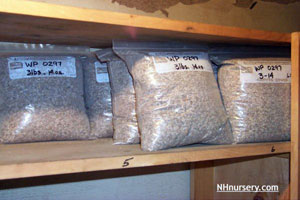
Seed in Cold Storage

Fall Sowing
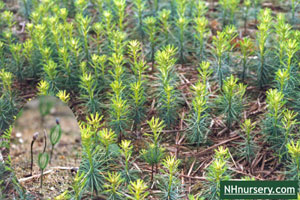
Success!
Sowing
Many nurseries have sown untreated dormant seeds of some species in the fall. In that way, seeds receive what amounts to a warm, then cold afterripening. Not only does this practice lower production costs by eliminating or lessening presowing treatments, but it can usually be done in the fall after seed collection and processing but before winter freeze up. Labor demands are lower then, and in New Hampshire, soil conditions are more favorable for planting.
Certain conditions must be met before fall sowing is successful. First, the seeds must be of high quality. Weak or damaged seeds will rarely survive over winter. Even good seeds need protective mulching in cold regions, i.e. New Hampshire. Time of sowing is also very important. Seeds sown too early may germinate before winter and be lost. Seed sown too late may not get the full after-ripening effect before the ground freezes. Intermittent germination and poor stocking will be the result. For New Hampshire, most species do best when sown in October and November.
(Taken from the Seeds of Woody Plants in the United States, 1974, USDA Forest Service Agricultural Handbook No. 450)
NH State Forest Nursery |
Division of Forests and Lands
Department of Natural and Cultural Resources
172 Pembroke Road, Concord, NH 03301
(603) 796-2323 | fax: (603) 271-6488


